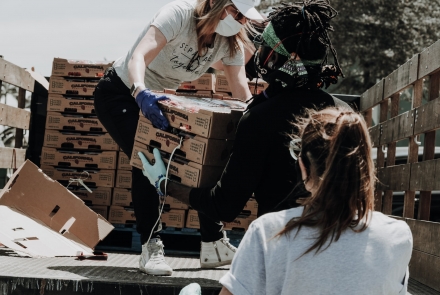
Photo by Joel Muniz on Unsplash
Volunteering far and wide
As the volunteering ecosystem recovers from the COVID-19 pandemic, work will be needed to support the recovery of formal volunteering, but knowing more about informal volunteering is crucial too, Sue Regan writes.
When the government launched the National Recovery and Resilience Agency in the lead up to the federal budget, an undercurrent of concern already simmered in the social sector. The prime minister’s media release referred to $600 million of new funding for projects to bushfire and cyclone-proof houses, build levees in disaster-prone areas, and improve telecommunications infrastructure.
The Australian Council of Social Service (ACOSS) highlighted the need to look beyond physical infrastructure, urging investment in community leaders and organisations that build the resilience of people and communities. David Crosbie, CEO of the Community Council of Australia, pointed to the role of charities in building community resilience and how this has never been more important.
The government’s renewed community resilience agenda needs to invest in social infrastructure, which includes charities and other organisations, and all those who work, both paid or unpaid, for these organisations. Additionally, it needs to better understand the array of activity that occurs informally in the community.
In 2015, following extensive consultation, Volunteering Australia adopted a broad definition of volunteering as ‘time willingly given for the common good and without financial gain’, aligning with international definitions of volunteering.
This includes what typically gets called ‘formal volunteering’, that takes place within organisations, and ‘informal volunteering’, which occurs informally in the community, outside of an organisational setting.
The scale and characteristics of formal volunteering are well known.
For example, the Australian Bureau of Statistics General Social Survey has measured formal volunteering levels since 2002. These numbers show that nearly six million people participated in voluntary work for an organisation in 2019.
They also show the diverse nature of those activities and in what types of organisations they are happening – with sports clubs, religious groups and educational organisations being the top three. Nearly 600 million hours of volunteer work were undertaken through organisations in 2019.
Alongside official data, a rich history of volunteering research and the ongoing work of peak volunteering bodies, and others, means formal volunteering is well understood by the policy-making community.
This is in contrast with informal volunteering – its scale, frequency, and the nature of its contribution remain opaque and poorly understood. The most recent General Social Survey published in 2020 did include informal volunteering for the first time, and data shows that about one third of the Australian population aged 15 years and over participated in informal volunteering in the four weeks prior to the survey.
The common forms of informal volunteering captured by this data include providing transport, running errands, domestic work, home maintenance, and emotional support.
But this new data is only scraping the surface of understanding the informal volunteering activity occurring in Australian communities.
One sub-set of informal volunteering is community-led initiatives that seek to solve collective problems. This includes groups forming in response to a local need and self-organising – for example to support women affected by domestic violence or young people in trouble, or to improve the neighbourhood environment.
Recent research by Carolyn Hendriks and Albert Dzur suggests community-led initiatives can form under a variety of conditions and for differing reasons. This presents challenges for both governments and formal civil society organisations like volunteering peak bodies in knowing how and when to engage and support this informal activity, or when to leave well alone.
Starting to address these challenges requires information and knowledge that Australia’s leaders in this area currently lack.
As the national peak body for volunteering, Volunteering Australia’s role is to advocate for and advance all forms of volunteering. At the onset of the COVID-19 pandemic, a simple scanning of social media revealed extensive informal volunteering activity occurring – sometimes individuals acting alone, at other times, ‘mutual aid’ groups formed to support community wellbeing.
Often facilitated through social media, these activities were important part of the pandemic response, but bodies like Volunteering Australia struggled to know how to respond.
This is because of a relative lack of understanding of informal volunteering. This is unsustainable. The volunteering sector – peak bodies, volunteer support services and others – needs to evolve to embrace this more self-organising approach to voluntary activity, but it needs more data to do so.
This is especially pressing given trends in formal volunteering in Australia. The rate of volunteering through an organisation has declined over time: for people aged 18 years and over, the rate has declined from 36 per cent in 2010 to 29 per cent in 2019. The number of hours volunteers contributed through organisational engagement fell 20 per cent over this period.
New research published during this National Volunteer Week by Nick Biddle and Matt Gray shows formal volunteering is yet to recover from the impact of COVID-19 restrictions. An estimated 2.3 million less Australians were volunteering in April 2021 than there were in late 2019.
Across the volunteering ecosystem, further work will be needed to support the recovery of formal volunteering. This should be a priority not least because community sector organisations typically operate a business model that relies on the engagement of volunteers. Alongside this, the sector needs to explore how it could tap into the informal volunteering activity occurring across Australia.
This means understanding more about whether people are switching from formal to informal community contribution or whether one reinforces the other. It also means asking how governments, formal civil society organisations, informal volunteers, and self-organising groups might collaborate, or at least how they can complement and learn from each other better.
As the new National Recovery and Resilience Agency gets up and running, the relationship between volunteering and building community resilience should be a key focus of its attention, as it increasingly has been at the global level. In progressing this agenda, understanding the full breadth and diversity of volunteering matters and, at least for Australia, this means shining more on informal volunteering.
Updated: 21 November 2024/Responsible Officer: Crawford Engagement/Page Contact: CAP Web Team












